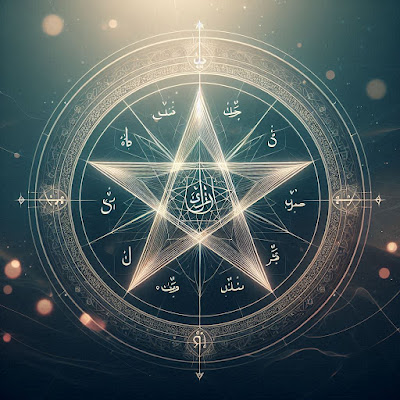Rabb (ربّ) and the Balance of Arḍ & Samw
Rabb (ربّ) and the Balance of Arḍ & Samw
The word Rabb (ربّ) in the Arabic language does not simply mean “Lord” in the general sense that we often assume. It carries deeper meanings of nurturing, sustaining, developing, and bringing something to its completion. It is not a static title but rather a dynamic process—one that encompasses growth, refinement, and the fulfillment of potential.
When we place the concept of Rabb in the context of Arḍ (earth) and Samw (elevation, heavens), we begin to see an incredible pattern unfold.
1. Rabb of Arḍ (أرض): The One Who Nurtures the Rooted and the Material
The Rabb of Arḍ is the nurturer, sustainer, and developer of all that is grounded, tangible, and foundational. The earth is a place of creation, sustenance, and growth. It is where things take root, develop, and mature.
Allah says in the Qur’an:
“إِنِّي جَاعِلٌ فِي ٱلْأَرْضِ خَلِيفَةً”
“Indeed, I am placing a khalifah on the earth.” (Qur’an 2:30)
This verse establishes that earth is the place of action, trial, and purpose. It is where the divine plan unfolds, and it is where human beings are tested, molded, and prepared for something greater.
Just as plants must grow through the soil, pushing against resistance before reaching the sunlight, human beings must also struggle, learn, and evolve before attaining enlightenment.
2. Rabb of Samw (سَمْو): The One Who Elevates Towards Completion
The Rabb of Samw is the one who refines, raises, and completes what is lofty, high, and transcendent.
Allah states in the Qur’an:
“يَرْفَعُ ٱللَّهُ ٱلَّذِينَ ءَامَنُوا”
“Allah raises those who believe.” (Qur’an 58:11)
This raising or elevation applies both in the physical sense—referring to the heavens, the vast expanse of the sky—and in the spiritual sense, as in the lifting of the soul towards wisdom, enlightenment, and truth.
In this way, Samw represents guidance, ascension, and spiritual completion. While Arḍ is the foundation, Samw is the destination. The journey of life is a movement from the lowliness of the earth to the heights of the heavens, from material existence to divine connection.
3. The Root of Creation: Lowliness as the Beginning
Everything that exists in the material world begins in a state of lowliness before it can rise.
- The earth (Arḍ) is the starting point of all creation.
- The human being is created from “طِين” (ṭīn, clay)—a substance that is humble, malleable, and seemingly insignificant.
- Yet, within this clay is placed the divine spirit (روح, rūḥ), which allows human beings to ascend beyond their physical limitations.
The Qur’an reminds us:
“وَعِبَادُ ٱلرَّحْمَٰنِ ٱلَّذِينَ يَمْشُونَ عَلَى ٱلْأَرْضِ هَوْنًا”
“The servants of the Most Merciful walk upon the earth humbly.” (Qur’an 25:63)
This highlights a profound reality: humility is the beginning of ascension. Just as a seed must be buried in the soil before it can grow into a towering tree, a person must first lower themselves in humility before they can be elevated in knowledge, wisdom, and nearness to Allah.
4. The Cosmic Duality of Arḍ and Samw in the Qur’an
The relationship between Arḍ and Samw appears repeatedly in the Qur’an, emphasizing that Allah governs both the physical and the metaphysical, the visible and the unseen:
“وَهُوَ ٱلَّذِي فِي ٱلسَّمَاءِ إِلَٰهٞ وَفِي ٱلْأَرْضِ إِلَٰهٞ”
“He is God in the heavens and the earth.” (Qur’an 43:84)
“لَهُۥ مَا فِي ٱلسَّمَٰوَٰتِ وَمَا فِي ٱلْأَرْضِ”
“To Him belongs whatever is in the heavens and the earth.” (Qur’an 2:255)
This tells us that Allah is the master of both the seen and the unseen, the finite and the infinite, the worldly and the spiritual.
5. Literary and Mystical Perspectives on Arḍ & Samw
This divine structure has been deeply explored by scholars, mystics, and poets throughout history:
📖 Ibn al-‘Arabi (Sufi interpretation):
"The soul descends into the earth (body, material existence) but must rise back to the heavens (divine connection, enlightenment)."
💡 Imam Ali (as):
"Be among the people of the heavens while you walk on earth."
(Implying that one’s values, mindset, and heart should be connected to higher realities even while existing in the material world.)
🌊 Jalal ad-Din Rumi:
"You were born with wings; why prefer to crawl?"
(Emphasizing that human beings are created with the potential for spiritual elevation, yet many remain confined to earthly distractions.)
Final Reflection: Arḍ & Samw as a Metaphor for Life
Our entire existence is defined by this tension between earth and sky.
- We are rooted in dust, yet we seek the heights.
- We start in lowliness, but we are meant for ascension.
- We exist in the realm of Arḍ, but we are drawn toward the reality of Samw.
The Rabb of both Arḍ and Samw governs this journey, guiding us from our earthly foundation to our higher purpose.
So when we say “Rabb of the lowliness and the elevation,” we are recognizing that:
🌎 He nurtures us from the ground up. (Earth, body, trials, physical sustenance)
☁️ He elevates us towards the highest station. (Soul, knowledge, enlightenment, divine connection)
Thus, to rise, we must be firmly rooted.
To ascend, we must first understand where we stand.
May we always seek balance between the two, fulfilling our potential both in this world and the next.




Comments
Post a Comment